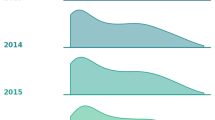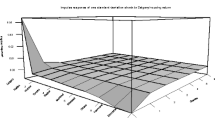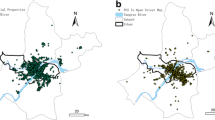Abstract
We apply spatio-temporal scan statistics on the distributions of asking price per meter squared for various segments of the housing market (attics, houses, flats of various sizes) in the city of Madrid for 5 years during the period 2008–2019. Our application shows how spatio-temporal scan statistics can be useful for assessing the dynamics of urban spatial structure analyzed through the lens of housing prices. The focus on the post-2008 period and the computation of prospective clusters allows to detect the winners and the losers of the 2008 real estate crisis and to uncover new trends during the post-crisis period. We show that the economic crisis in Madrid has had a strong impact on housing market with increased polarization between the center and the periphery and between the northern and southern areas of Madrid, with some heterogeneity depending on the neighborhood, on the market segment, and on the urban policies undertaken.
Similar content being viewed by others
Notes
- 1.
- 2.
Kulldorff (2001) discusses the limitations in using the spatial version of the scan test for each temporal period instead of using the spatio-temporal version of the scan statistic.
- 3.
Defined here as the observations that are above Q3 + 1.5(Q3 – Q1) or below Q1 – 1.5(Q3 – Q1), where Q1 and Q3 are, respectively, the first and the third quartile of the distribution.
- 4.
For ease of exposition, we present the results in terms of “high price clusters” or “low price clusters,” whereas they are strictly defined as clusters of high (respectively, low) prices per meter square in logs.
- 5.
In what follows, the numbers in brackets represent the number of the district that can be visualized in Fig. 2.
References
Anselin L (1995) Local indicators of spatial association – LISA. Geograph Anal 27:93–115
Anselin L, Lozano-Gracia N (2008) Spatial hedonic models. In: Mills T, Patterson K (eds) Palgrave handbook of econometrics. Applied econometrics, vol 2. Springer, Berlin, pp 1214–1250
Arribas-Bel D, Tranos E (2018) Characterizing the spatial structure(s) of cities “on the fly”: the space-time calendar. Geograph Anal 50(2):162–181
Baum-Snow N, Ferreira F (2015) Causal inference in urban and regional economics. In: Duranton G, Henderson V, Turner M, Zhang Q (eds) Handbook of regional and urban economics. Amsterdam: Elsevier, 5:3–68
Bersimis S, Chalkias C, Anthopoulou T (2014) Detecting and interpreting clusters of economic activity in rural areas using scan statistic and LISA under a unified framework. Appl Stoch Models Bus Ind 30:573–587
Bhatt V, Tiwari N (2014) A spatial scan statistic for survival data based on Weibull distribution. Stat Med 33(11):1867–1876
Brueckner JK, Thisse JF, Zénou Y (1999) Why is central Paris rich and downtown Detroit poor? An amenity-based theory. Eur Econ Rev 43(1):91–107
Chasco C, Le Gallo J (2013) The impact of objective and subjective measures of air quality and noise on house prices: a multilevel approach for downtown Madrid. Econ Geogr 89:127–148
Chasco C, Le Gallo J, López FA (2018) A scan test for spatial groupwise heteroscedasticity in cross-sectional models with an application on house prices in Madrid. Reg Sci Urban Econ 68:226–238
Cheshire P, Sheppard S. (1998) Estimating the demand for housing, land, and neighborhood characteristics. Oxf Bull Econ Stat 60:357–382
Cucala L (2016) Scan statistics for detecting high-variance clusters. J Probab Stat. https://doi.org/10.1155/2016/7591680
Cucala L, Genin M, Lanier C, Occelli F (2017) A multivariate Gaussian scan statistic forspatial data. Spatial Statistics, 21:66–74
Cucala L, Demattei C (2016) Spatial cluster detection for socio-economic data. Case Stud Bus Ind Gov Stat 6(2):1–9
Diggle PJ, Chetwynd AG, Haggkvist R, Morris SE (1995) Second-order analysis of space-time clustering. Stat Methods Med Res 4:124–136
Fuchs S, Ornetsmüller C, Totschnig R (2012) Spatial scan statistics in vulnerability assessment: an application to mountain hazards. Nat Hazards 64(3):2129–2151
Fujita M (1989) Urban economic theory: land use and city size. Cambridge University Press, Cambridge
Getis A, Ord JK (1992) The analysis of spatial association by use of distance statistics. Geograph Anal 24:189–206
Han J, Zhu L, Kulldorff M, Hostovich S, Stinchcomb DG, Tatalovich Z, Feuer EJ (2016) Using Gini coefficient to determining optimal cluster reporting sizes for spatial scan statistics. Int J of Health Geograph 15(1):27
Helbich M (2012) Beyond postsuburbia? Multifunctional service agglomeration in Vienna’s urban fringe. Tijdschrift voor Economische en Sociale Geografie 103(1):39–52.
Huang L, Kulldorff M, Gregorio D.A. (2007) A Spatial Scan Statistic for Survival data. Biometrics, 63:109–118
Huang L, Pickle LW, Das B (2008) Evaluating spatial methods for investigating global clustering and cluster detection of cancer cases. Statistics in Medicine, 27(25):5111–5142
Huang L, Tiwari RC, Pickle LW, Zou Z (2010) Covariate adjusted weighted normal spatial scan statistics with applications to study geographic clustering of obesity and lung cancer mortality in the United States. Stat Med 29(23):2410–2422
Hui ECM, Liang C (2015) The spatial clustering investment behavior in housing markets. Land Use Policy 42:7–16
Jung I, Kulldorff M, Richard OJ (2010) A spatial scan statistics for multinomial data. Stat Med 29:1910–1918
Kang H (2010) Detecting agglomeration processes using space-time clustering analysis. The Annals of Regional Science 45(2):291–311
Kim S, Jung I (2017) Optimizing the maximum reported cluster size in the spatial scan statistic for ordinal data. Plos One, 12(7), e2017-08-10.
Kleinman K (2015) rsatscan: tools, classes, and methods for interfacing with SaTScan stand-alone software. R package version 0.3.9200. https://CRAN.R-project.org/package=rsatscan
Kosfeld R, Titze M (2015) Benchmark value-added chains and regional clusters in R&D-intensive industries. Int Reg Sci Rev 40(5):530–558
Kulldorff M (1997) A spatial scan statistic. Commun Stat-Theory Methods 26(6):1481–1496
Kulldorff M (2001) Prospective time periodic geographical disease surveillance using a scan statistic. J R Stat Soci Ser A (Stat Soci) 164(1):61–72
Kulldorff M, Nagarwalla N (1995) Spatial disease cluster: detection and inference. Stat Med 14:799–810
Kulldorff M, Huang L, Konty K (2009) A scan statistic for continuous data based on the normal probability model. Int J Health Geograph 8(1):8–58
López FA, Maté ML, Artal-Tur A (2013) Evaluating three proposals for testing independence in non linear spatial processes. Estadística Española 55(180):55–75
López FA, Paez A (2017) Spatial clustering of high-tech manufacting and knowledge-intensive service firms in the Greater Toronto area. Can Geogr 61(2):240–252
López FA, Chasco C, Le Gallo J (2015) Exploring scan methods to test spatial structure with an application to housing prices in Madrid. Pap Reg Sci 94(2):317–346
Le Gallo J, López FA, Chasco C (2020, forthcoming) Testing for spatial group-wise heteroscedasticity in spatial autocorrelation regression models: lagrange multiplier scan tests. Ann Reg Sci 64(2):287–312
Li A, Tsou M-T, Crook SES, Chun Y, Spitzberg B, Gawron JM, Gupta DK (2015) Space-time analysis: concepts, quantitative methods and future directions. Ann Assoc Am Geograph 105(5):1–23
Lois González RC (2019) Housing and housing policies in Madrid in the light of real estate crisis, protest and new regulatory policies. In: Wehrhahn R, Pohlan J, Hannemann C, Othengrafen F, Schmidt-Lauber B (eds) Housing and Housing Politics in European Metropolises. Jahrbuch StadtRegion 2017/2018. Springer VS, pp 45–70
Madouasse A, Marceau A, Lehébel A, Brouwer-Middelesch H, van Schaik, G, Van der Stede Y, Fourichon C (2014) Use of monthly collected milk yields for the detection of the emergence of the 2007 French BTV epizootic. Prev Vet Med 113(4):484–491
Montrone S, Perchinunno P, Di Giuro A, Rotondo F, Torre CM (2009) Identification of “hot spots” of social and housing difficulty in urban areas: scan statistics for housing, market and urban planning policies. In: Murgante B, Borruso G, Lappucci A (eds) Geocomputation and urban planning. Springer, Berlin
Naus JI (1965) Clustering of random points in two dimensions. Biometrika 52(1):263–267
Ord JK, Getis A (1995) Local spatial autocorrelation statistics: distributional issues and an application. Geograph Anal 27:286–305
Orford S (2000) Modelling spatial structures in local housing market dynamics: a multilevel perspective. Urban Stud 37:1643–1671
Piñeira Mantiñán MJ, Lois González R.C, González Pérez JM (2018) New models of urban governance in Spain during the post-crisis period: the fight against vulnerability on a local scale. Territory Politics Gov 7(3):336–364
Tuia D, Kaiser C, Dan Cunha A, Kanevski M (2009) Detection of urban socio-economic patterns using clustering techniques. In: Murgante B, Borruso G, Lappucci A (eds) Geocomputation and urban planning. Springer, Berlin
Tulumello S, Cotella G, Othengrafen F (2020) Spatial planning and territorial governance in Southern Europe between economic crisis and austerity policies. Int Plan Stud 20:72–87
Watkins CA (2001) The definition and identification of housing submarkets. Environ Plan A 33(12):2235–2253
Zhang Z, Assunção R, Kulldorff M (2010) Spatial scan statistics adjusted for multiple clusters. J Probab Stat. https://doi.org/10.1155/2010/642379
Acknowledgements
Fernando A. López is supported by the program Groups of Excellence of the Region of Murcia, Fundación Séneca, Science and Technology Agency of the region of Murcia project 19884/ GERM/15 and by Spanish Ministry of Economics and Competitiveness (PID2019-107800GB-I00/AEI/10.13039/501100011033)
Author information
Authors and Affiliations
Corresponding author
Editor information
Editors and Affiliations
Section Editor information
Rights and permissions
Copyright information
© 2020 Springer Science+Business Media, LLC, part of Springer Nature
About this entry
Cite this entry
Chasco, C., Le Gallo, J., López, F.A. (2020). The Spatial Structure of Housing Prices in Madrid: Evidence from Spatio-temporal Scan Statistics. In: Glaz, J., Koutras, M.V. (eds) Handbook of Scan Statistics. Springer, New York, NY. https://doi.org/10.1007/978-1-4614-8414-1_58-1
Download citation
DOI: https://doi.org/10.1007/978-1-4614-8414-1_58-1
Published:
Publisher Name: Springer, New York, NY
Print ISBN: 978-1-4614-8414-1
Online ISBN: 978-1-4614-8414-1
eBook Packages: Springer Reference MathematicsReference Module Computer Science and Engineering




